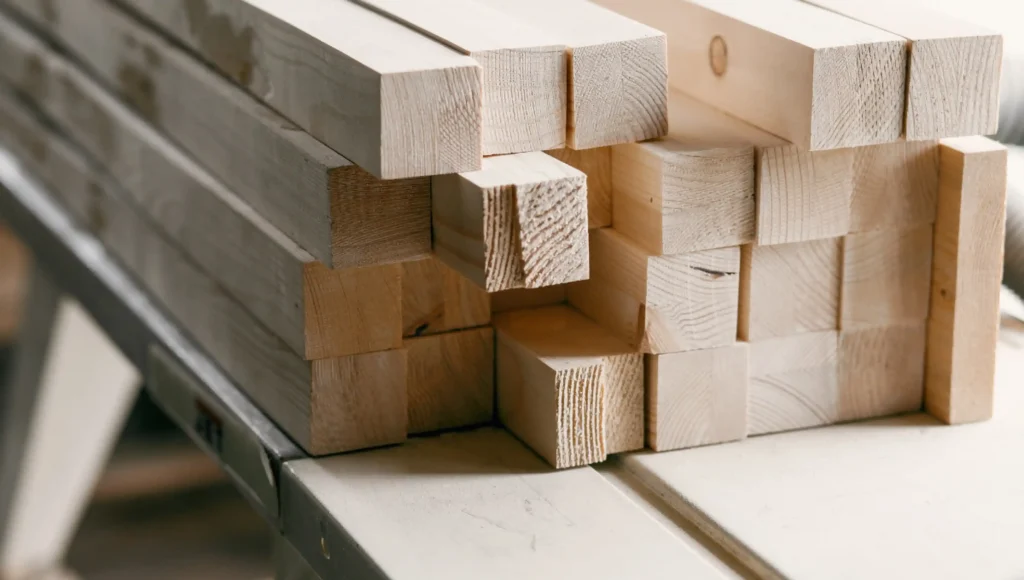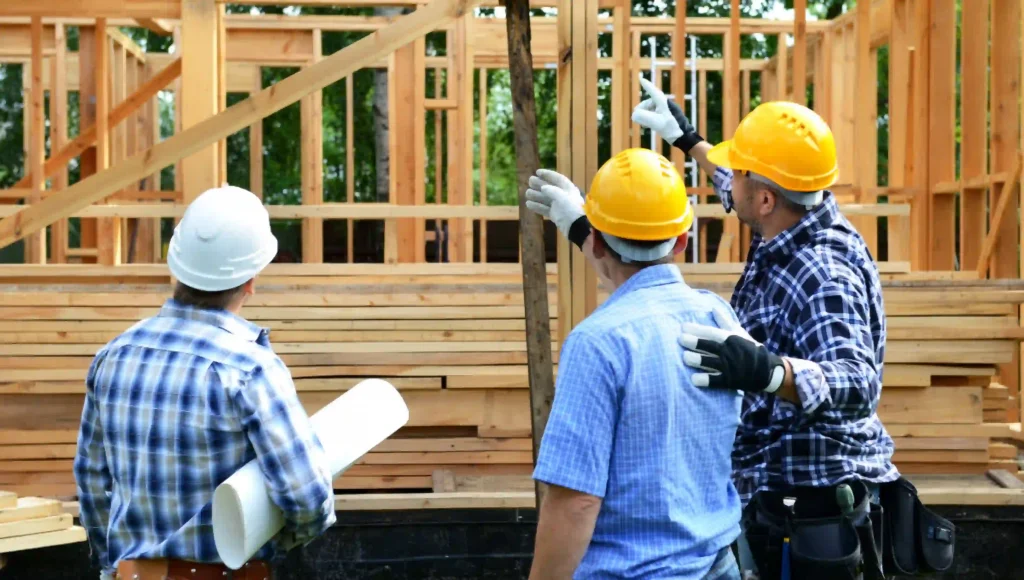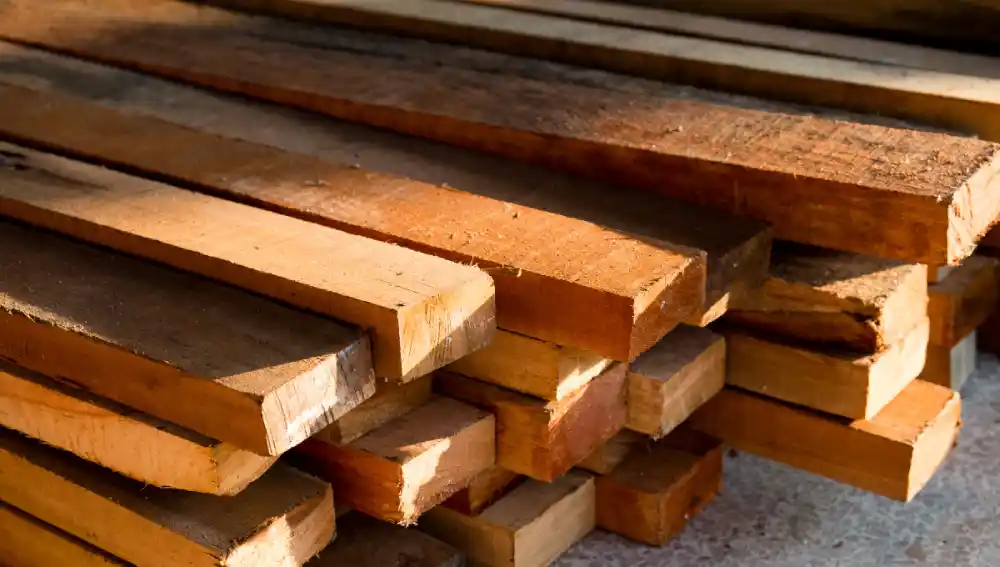Timber has been essential in construction for centuries. It is a useful material for many building needs. People have used it in everything from ancient wooden huts to modern high-rises. Timber’s role in construction has undergone a profound revolution. Today, we appreciate it. It has strong structure, beauty, and green benefits.
Types of Timber Used in Construction

Softwoods
Softwoods have come from coniferous trees. People value them. They grow fast. This makes them a sustainable option for construction.
Common types include pine, fir, and cedar.
Characteristics and uses.
- Pine woods are light in weight, easy to work with, and cost-effective. It serves as a material for framing, forming panels, and making floors.
- Fir is Strong and durable, often used in structural framing and exterior applications.
- Cedarwood resists decay and repels insects. This makes it great for outdoor use, such as for decking and siding.
Hardwoods
Hardwoods come from deciduous trees. They are usually denser and tougher than softwoods. This makes them good for busy areas and long-lasting installations.
Example: Oak, Maple, and Mahogany
Characteristics and uses.
- Oak is very durable. This makes it a popular choice for floors, furniture, and cabinets.
- Maple wood is strong and used for floors and cabinets because it can handle bumps and hits.
- Mahogany is valued for its beauty and durability, making it perfect for high-quality furniture and decorative items.
Engineered wood products
Engineered wood products have the benefits of natural timber. They also have improved performance. They provide solutions for many construction challenges.
Examples: Plywood, Laminated Veneer Lumber (LVL), Cross-Laminated Timber (CLT)
Benefits and applications.
- Manufacturers glue wood veneers together to create plywood.
- Plywood serves as a primary material for subflooring, and wall construction. It is a popular choice for wall construction, roof sheathing, and cabinet making.
- LVL consists of many thin wood layers glued together. This structure gives it great strength and stability. It’s used for beams and joists.
- CLT is a prefabricated wood panel. People use this material for walls, roofs, and floors. CLT’s strength, stability, and eco-friendliness are well-known.
Structural Uses of Timber
Framing
Timber framing is popular for homes and businesses. It is flexible and strong.
- Timber frames for residential and commercial buildings
Timber framing offers a strong skeleton for homes and commercial structures. It can fit many styles.
- Post and beam construction
This traditional method uses heavy timber beams and posts. They create open, spacious interiors without load-bearing walls.
Roofing
Timber is crucial to roofing. It provides both structure and beauty.
- Trusses, rafters, and sheathing.
Roofs have trusses and rafters for support, and sheathing provides a strong base for the roof.
- Benefits of timber roofing systems.
Timber is light but strong. It allows for versatile roof designs and easier installation. This stands out among other materials in a positive way.
Flooring
Timber flooring options range from structural components to beautiful finished surfaces.
- Joists and subflooring.
Timber joists support the floor’s weight and any occupants or furnishings. Subflooring provides a sturdy surface for finished flooring.
- Finished timber floors.
Finished timber floors add warmth and elegance to interiors. They come in many kinds of wood and finishes.
Non-Structural Uses of Timber

Interior Design
Timber enhances interior spaces through both functional and decorative applications.
- Panelling, mouldings, and trim
These elements add character and detail to the interiors. They have aesthetic and acoustic benefits. They dampen sound and create a warm feeling.
Furniture and Fixtures
Timber is a popular choice for crafting durable and flexible furniture pieces.
- Built-in furniture, cabinetry, and shelving
Timber is versatile. It allows for custom-built furniture. This furniture can fit with any design style.
- Durability and design flexibility
Its strength ensures longevity. Its workability allows for intricate and custom finishes.
Decorative Elements
Timber is beautiful. It is great for decor that improves inside and outside spaces.
- Timber cladding and siding
Timber cladding is used for exterior walls. It gives a rustic or modern look and protects the building from the elements.
- Beams and columns as aesthetic features
Exposed timber beams and columns add a rustic charm. They also add architectural interest to spaces.
Benefits of Using Timber in Construction
Sustainability
Timber emerges as a sustainable, eco-conscious building material alternative.
- Renewable resources and carbon sequestration.
Trees absorb CO2 as they grow. Trees harvested with sustainable methods store carbon deposits. This helps to reduce climate change.
- Certifications and sustainable forestry practices.
Certifications, such as FSC and PEFC, ensure that timber comes from well-managed forests. They promote biodiversity and reduce environmental impact.
Environmental Impact
Timber has a lower environmental footprint compared to many other construction materials.
- Low embodied energy, compared to other materials.
Making timber products uses less energy than materials such as steel or concrete. This reduction in total greenhouse gas emissions is significant.
- Recyclability and biodegradability.
Timber can cut waste. By reusing, recycling, or biodegrading it.
Thermal and Acoustic Insulation
Timber boosts building insulation and reduces sound efficiency.
- Natural insulation properties.
Timber’s cells give great insulation. They keep buildings warm in winter and cool in summer.
- Sound absorption and noise reduction.
Timber can absorb sound. This makes it effective for reducing noise in buildings. It enhances comfort and privacy.
Conclusion
Timber remains vital in modern construction. It offers sustainability, strength, and beauty. Users use this Construction Material in both structural and nonstructural applications. Builders and architects prefer it. By using timber, we’ve gained from its properties. We also help build a more green construction industry.
FAQs
Timber is best used for structural framing, flooring, roofing, decking, and furniture. It is versatile, strong, and looks natural. It’s great for indoor and outdoor use. It adds durability and a warm, natural finish to many projects in construction and design.
Protect timber. Do this by applying wood preservatives and sealing with stains or paints. Also, ensure proper ventilation to reduce moisture. Select species with innate resistance, such as cedar and redwood. Regular maintenance is essential. It includes reapplying treatments and inspecting for damage. These steps keep timber in good condition.

